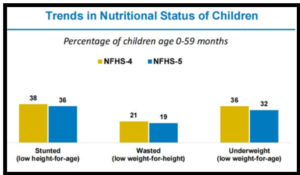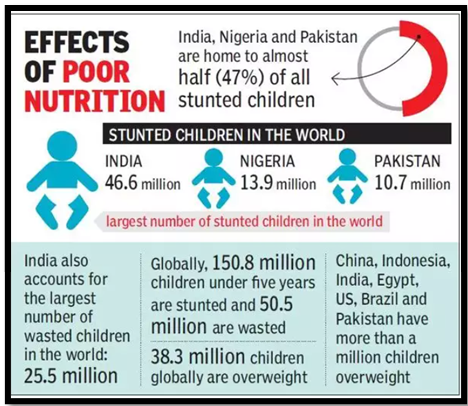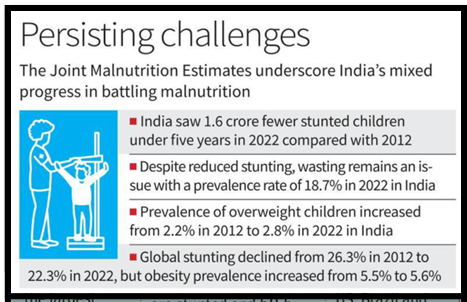GROWTH CHARTS — WHO STANDARDS VERSUS INDIA CRAFTED
Syllabus
- GS2 : Issues relating to Poverty and Hunger
Why in the News?
- Childhood undernutrition remains a persistent challenge in India, necessitating accurate measurements for effective monitoring.
- While using the World Health Organization (WHO) Growth Standards has spurred debates, considering revisions, it is crucial to balance aspirations with practicality and global comparability.
Source: Mediaindia.net
Persistent Undernutrition in India: A Complex Challenge
Determinants of Undernutrition
- Childhood undernutrition in India is a multifaceted challenge.
- Influenced by factors like food intake, dietary diversity, health, sanitation, women’s status, and the overarching context of poverty.
Anthropometric Standards
- The primary metrics for measuring undernutrition, such as stunting (chronic undernutrition) and wasting (acute undernutrition), rely on anthropometric standards like height-for-age and weight-for-height.
- Monitoring these standards, crucial for tracking progress, utilizes the globally accepted World Health Organization (WHO) Growth Standards in India.
Emergent Debate
- Despite global standards, debates arise on issues related to their applicability and relevance in the unique context of India.
MGRS and WHO Growth Standards
Multicentre Growth Reference Study (MGRS)
- The World Health Organization (WHO) Growth Standards find their roots in the MGRS, a comprehensive study spanning six countries (Brazil, Ghana, India, Norway, Oman, and the United States) from 1997 to 2003.
- This study focused on children without known environmental deficiencies, aiming to establish growth standards from birth to five years.
Prescriptive Approach
- Unlike previous references that were U.S.-centric and included formula-fed children, the MGRS adopted a prescriptive stance.
- It aimed to set growth ‘standards’ dictating how children should grow under optimal conditions, deviating from mere growth ‘references.’
India’s MGRS Sample
- In India, the MGRS sample was drawn from privileged households in South Delhi.
- These children met stringent eligibility criteria, enjoying favorable growth environments, breastfeeding, and having non-smoking mothers.
- The study raises questions about the universality of these standards given the specific socio economic context of the sampled population.
Challenges in Evaluating Growth Standards in India
Overestimation Concerns
- Some researchers argue that the WHO Growth Standards may overestimate undernutrition in India.
- However, meaningful comparisons with other surveys require samples meeting MGRS-defined criteria for favorable growth environments, posing challenges given India’s significant inequality.
Data Disparities
- Large-scale surveys in India struggle to provide equivalent samples due to pervasive inequality.
- In NFHS-5 (2019-21), even among the highest quintile households, only 12.7% of children (six-23 months) meet WHO’s ‘minimum acceptable diet.’
- Educational differences further highlight disparities, with 7% of NFHS-5 women completing 12 or more years of schooling compared to highly educated MGRS mothers.
Comparative Challenges
- Comparisons between WHO-MGRS and prevalence studies, like NFHS or Comprehensive National Nutrition Survey, can be misleading due to differing study norms.
- MGRS’s comprehensive approach, including counseling for proper feeding practices, contrasts with the absence of such measures in prevalence studies.
- Acknowledging MGRS’s unique purpose of setting prescriptive standards resolves sampling concerns.
- Additional methodological concerns, like data pooling across countries, have been extensively addressed in the study reports, ensuring a nuanced understanding of the growth standards’ applicability.
Source: Times of India
Genetic growth, other concerns
Genetic Variability
- The MGRS standards may not fully consider the unique genetic growth potential of Indians compared to others, raising concerns about their applicability.
- Genetic factors play a crucial role in individual growth, while maternal height significantly influences a child’s development.
Intergenerational Deprivation
- Low average maternal heights, linked to poverty and poor women’s status, indicate an environment of deprivation.
- Stunting, as an indicator of deficiency, must effectively capture this intergenerational transmission of hardship to provide a comprehensive measure of the prevailing environment.
Adaptability of Standards
- Questions arise about the adaptability of WHO-MGRS standards, given concerns about maternal heights and genetic potential.
- The standards may be considered too plastic or flexible to provide accurate assessments.
Global Disparities
- Several countries with similar or lower economic conditions, especially in South Asia, have recorded higher improvements in stunting prevalence using WHO-MGRS standards.
- This raises questions about the applicability of the standards across diverse populations.
Regional Disparities in India
- Within India, regional variations in stunting prevalence and adult height increases, observed in states like Odisha, Chhattisgarh, Tamil Nadu, and Kerala, highlight substantial differences in progress rates.
Population-Level Genetic Shifts
- Socio-economic development triggers population-level shifts in gene pools, challenging the notion of static genetic potential.
- Japan’s increasing average heights exemplify such dynamic changes.
Misdiagnosis and Overfeeding Concerns
Risk of Overfeeding
- Inappropriately high standards may lead to misdiagnosis and potential overfeeding of misclassified children, contributing to the rising challenge of overweight and obesity.
Concerns about Non-communicable Diseases (NCDs)
- Given the escalating burden of non-communicable diseases (NCDs) in India, misdirected interventions could exacerbate the problem.
Quality Improvement in Nutrition Programs
- Enhancing the quality of programs like mid-day meals and supplementary nutrition in anganwadis is crucial.
- Meals should prioritize nutrient diversity, including items like eggs, and pulses in the Public Distribution System.
Source: The Hindu
Holistic Approach for Nutritional Outcomes
- Apart from dietary improvements, addressing factors such as sanitation, healthcare access, and childcare services is imperative for comprehensive and improved nutritional outcomes.
Addressing Distal Determinants
- Filling gaps in distal determinants of stunting, including livelihoods, poverty, education access, and women’s empowerment, is crucial for overall development.
- These determinants are interconnected and pivotal for achieving equitable resource distribution.
Interconnected Development Goals
- The goals of reducing stunting are intricately linked to broader national development objectives.
- Anthropometric indicators serve to underscore, rather than diminish, the significance of addressing these multifaceted determinants.
Individual Growth and Judgement Calls
- Recognizing the unique growth trajectories of individual children, health professionals, particularly treating physicians, can exercise judgment in interpreting growth charts in the context of personalized care.
Global Standards for Comparative Analysis
- The use of appropriate global standards is vital for understanding population trends, facilitating international comparisons, and evaluating intra-country trends.
- A country-specific standard could compromise these advantages.
ICMR’s Committee on Growth References
- The Indian Council of Medical Research (ICMR) has formed a committee to revise growth references for India, proposing an in-depth nationwide study on child growth.
- The committee recommends the potential development of national growth charts based on this study.
Advocating WHO-MGRS Standards
- While welcoming efforts for precise data, adhering to the WHO-MGRS standards, with their aspirational yet achievable benchmarks, appears logical.
- This maintains comparability and aligns with the nation’s ambitious developmental goals for comprehensive inclusivity by 2047.
| WHO Multicentre Growth Reference Study (MGRS)
· The MGRS, conducted by the WHO from 1997 to 2003, aimed to revolutionize child growth standards globally. · Encompassing 8,500 children across Brazil, Ghana, India, Norway, Oman, and the USA, the study gathered anthropometric and socio-economic data. Primary Objectives · Develop culturally relevant growth standards for children aged 0-71 months. · Replace the outdated International Child Growth Reference (ICGR) from the 1970s. · Create a precise tool for identifying malnutrition or developmental delays in children. |
Source
Mains Practice Question
Evaluate the appropriateness and relevance of the World Health Organization (WHO) Growth Standards in the Indian context. Assess whether the standards accurately reflect the nutritional status of Indian children.

 Source: Mediaindia.net
Source: Mediaindia.net Source: Times of India
Source: Times of India Source: The Hindu
Source: The Hindu

